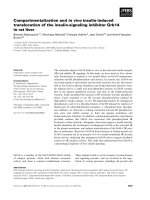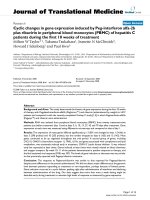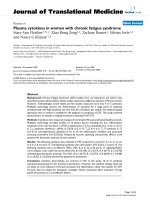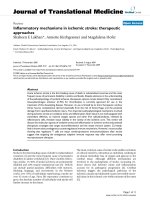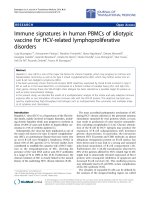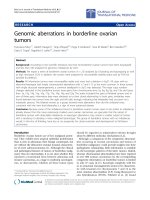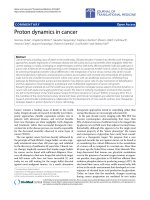báo cáo hóa học:" Measuring outcomes in allergic rhinitis: psychometric characteristics of a Spanish version of the congestion quantifier seven-item test (CQ7)" pdf
Bạn đang xem bản rút gọn của tài liệu. Xem và tải ngay bản đầy đủ của tài liệu tại đây (242.27 KB, 5 trang )
SHOR T REPOR T Open Access
Measuring outcomes in allergic rhinitis:
psychometric characteristics of a Spanish version
of the congestion quantifier seven-item test (CQ7)
Antonio Valero
1,3,4*
, Joaquim Mullol
2,3,4
, Michael Herdman
5,6,7
, Maria-José Rosales
8
, Spanish CQ7 Study Group
Abstract
Background: No control tools for nasal congestion (NC) are currently available in Spanish. This study aimed to
adapt and validate the Congestion Quantifier Seven Item Test (CQ7) for Spain.
Methods: CQ7 was adapted from English following international guidelines. The instrument was validated in an
observational, prospective study in allergic rhinitis patients with NC (N = 166) and a control group without NC
(N = 35). Participants completed the CQ7, MOS sleep questionnaire, and a measure of psychological well-being
(PGWBI). Clinical data included NC severity rating, acoustic rhinometry, and total symptom score (TSS). Internal
consistency was assessed using Cronbach’s alpha and test-retest reliability using the intraclass correlation
coefficient (ICC). Construct validity was tested by examining correlations with other outcome measures and ability
to discriminate between groups classified by NC severity. Sensitivity and specificity were assessed using Area under
the Receiver Operating Curve (AUC) and responsiveness over time using effect sizes (ES).
Results: Cronbach’s alpha for the CQ7 was 0.92, and the ICC was 0.81, indicating good reliability. CQ7 correlated
most strongly with the TSS (r = 0.60, p < 0.01), the PGWBI general health dimension (r = 0.56, p < 0.01), and the
MOS Sleep scale ‘sleep short of breath’ dimension (r = 0.49, p < 0.01). Correlations with acoustic rhinometry were
generally low. The instrument discriminated well between NC severity groups (ES 0.33-2.07) and AUC was 0.93,
indicating excellent sensitivity and specificity. The measure was responsive to change (ES = 1.1) in patients
reporting improvement in NC.
Conclusions: The Spanish version of the CQ7 is appropriate for detecting, measuring, and monitoring NC in
allergic rhinitis patients.
Findings
Objectives
Nasal congestion (NC) has been described as one of the
most troublesome symptoms for patients with allergic
rhinitis (AR) and is associated w ith poorer sleep, mood,
and productivity [1,2]. A new tool to measure patient
experience of NC is the Congestion Quantifier Seven-
Item test (CQ7) which was developed recently in the
United States [3]. The CQ7 was originally developed as
a screening tool to identify patie nts with NC potentially
requiring treatment and the original version was shown
to have excellent reliability, validity, sensitivity and
specificity, and responsiveness [3,4]. The objectives of
the present study were to a ssess the reliability, validity,
sensitivity and specificity, and responsiveness of a ver-
sion of the CQ7 for use in Spain.
Cultural adaptation and validation study
The CQ7 was adapted into Spanish for Spain following
a process of cultural adaptation based on international
recommendations, which included translation into Span-
ish by two independent translators, back-translation into
English, and cognitive debriefing in 10 patients with AR
and NC [5]. The psychometric properties of the Spanish
version were then tested in an observational, prospec-
tive, multicenter study carried out in the Allergology
departments of 17 Spanish hospitals. The majority of
patients made one study visit but in some centers they
* Correspondence:
1
Allergy Unit, Pneumology and Allergy Department, Hospital Clínic, Villarroel
170, Barcelona 08036, Spain
Full list of author information is available at the end of the article
Valero et al. Health and Quality of Life Outcomes 2011, 9:14
/>© 2011 Valero et al; licensee BioMed Central Ltd. This is an Open Access article distributed under the terms of the Creative Commons
Attribution License ( which permits unrestr icted use, dis tribution, and rep roduction in
any medium, provided the original work is properly cited.
made two (baseline and follow-up at one month) to
examine test-retest reliability and responsiveness.
The main study group (N = 166) were outpatients with
NC and a clinical diagnosis of intermittent or persistent
AR as defined in th e ARIA (Allergic Rhinitis in Asthma)
guidelines [6]. Patients could be treated or untreated for
AR and/or NC at the time of inclusion. Control subjects
(N = 35) had to be without NC on inclusion and there
was no requirement for a diagnosis of AR.
Variables collected at baseline wer e: age, gender, edu-
cational level, time from diagnosis of allergic rhinitis,
frequency and duration of nasal symptoms associated
with AR, presence of other diseases, treatment for AR,
overall NC severity (clinician and patient ratings), and
acoustic rhinometry (in selected centres). In acoustic
rhinometry testing (SER 2000, Rhinometrics, Lynge,
Denmark), nasal volume (V
0-7
) was assessed from the
nostril to 7 cm and minimum cross-sectional area
(mCSA) was assessed in both nostrils. Clinicians also
completed the Total Symptom Score (TSS) for all
patients. The TSS consists of 5 questions measuring AR
symptoms and provides an overall score raging from 0
(no symptoms) to 15 (very severe symptoms).
Patients completed the Spanish version of the Conges-
tion Quantifier Seven-Item Test (CQ-7), the Psychologi-
cal General Well -Being Index (PGWBI) [7], and the
Medical Outcomes Study Sleep Scale (MOS Sleep) [8,9].
The CQ-7 consists of 7 items answered on a scale from
0 (never) to 4 (always) with a total score ranging from 0
(no nasal congestion) to 28 (worst nasal congestion).
The overall score is a simple summation of the indivi-
dual item scores. The time frame for all instruments
was the previous week and all had been adapted and
validated for use in Spain [10,11].
Patients who attended the follow-up visit completed a
global rating of change item. The latter was used to
measure perceptions of change in NC from baseline on
a scale with 13 response options ranging from ‘ Avery
great deal better’ to ‘A very great deal worse’.
Ethics approval for the study was provided by the
Ethics Committee of the Hospital Clínic in Barcelo na
and all patients taking part in the study provided written
informed consent to participate.
Statistical analysis
The feasibility of the Spanish version of the CQ7 was
assessed by examining the proportion of missing
responses and the proportion of patients who found the
instrument easy to use. The proportion of patients with
the worst and best possible scores was calculated to esti-
mate floor and ceiling effects, while internal consistency
(reliability) was assessed using Cronbach’salphacoeffi-
cient [12]. Test-retest reliability was assessed by com-
puting the intraclass correlation coefficient (ICC) in
patients reporting no or only minimal change on the
global rating of change item [13]. Convergent validity
[13] was tested by analyzing the extent to which CQ7
scores demonstrated logical relationships with other
outcomes measures (PGWBI, MOS Sleep, TSS, acoustic
rhinometry) and known groups’ validity was tested by
determining the ability of the instrument to discriminate
between groups defined by different categories of sever-
ity on the NC severity rating item (according to both
patient and clinician overall ratings). T tests and effect
sizeswereusedtoanalyzetheextentofdifferences
between groups. Sensitivity and specificity were evalu-
ated using receiver operat ing characteristic (ROC) curve
analysis to determine w hether the questionnaire discri-
minated between patients with NC and controls.
Responsiveness to change was assessed by determining
the extent to which the instrument captured change in
health status in pa tients reportin g improvement or wor-
sening on the global rating of change item. Change over
time was analyzed using t tests and effect sizes. For all
analyses, the level of statistical significance was set at
0.05 and all analyses were performed i n version 13.0 of
SPSS.
Results
A total of 201 individuals participated in the validation
study (166 patients with NC and 35 controls without
NC). Sample characteristics are shown in Table 1. T he
study population was relatively young with a mean age
of 34.3 years, and a slight predominance of women.
TherewerenomissingresponsesonanyoftheCQ7
items in any of the study visits (see Table 2). The major-
ity of respondents (controls a nd patients) found the
questionnaire ‘ easy’ (33.3%) or ‘very easy’ (56.2%) to
complete. Ceiling and floor effects (1.2% and 0.6%,
respectively) were very small in the p atient sample.
Internal consistency was very satisfactory in the overall
sample (Cronbach’salphaof0.92)andtest-retestrelia-
bility assessed in patients reporting no or only minimal
change in NC at follow-up (n = 24) was also acc eptable
(ICC of 0.81).
Correlations between the CQ7 and other outcome
measures showed the expected patterns (Table 3). The
CQ7 score correlated most highly with the TSS (r =
0.60, p < 0.0001), though moderate to high correlations
were also seen with the vitality (r = 0.33, p < 0.0001)
and g eneral health (r = 0.56, p < 0.0001) dimensions of
the PGWBI. Correlations with the MOS Sleep question-
naire were highest for dimensions related with breathing
difficulties,i.e.the‘ sleep short of breath/headache’,
‘sleep disturbance’ and ‘snoring’ dimensions (correlations
of r = 0.49, 0.47, and 0.35, respectively; p < 0.0001).
Correlations with acoustic rhinometry values were gen-
erally low, particularly at the first visit.
Valero et al. Health and Quality of Life Outcomes 2011, 9:14
/>Page 2 of 5
The CQ7 discriminated well between groups defined
by NC severity (Figure 1). Between-group effect sizes
using clinician-rated NC severity ranged from 0.33 to
1.83 which would represent small and large effect sizes,
respectively. Similar results were observed using pat ient
self-ratings of overall NC severity.
The instrument showed good sensitivity and specificity
for detecting cases of nasal congestion with an area
under the ROC curve over 0.90 (AUC = 0.948, IC9 5%
[0.912 - 0.985]; p < 0.001). The optimum cut-point for
discriminat ing between cases and non-cases on the CQ7
was 7 points, which gave a sensitivity of 94% and a spe-
cificity of 85.7%.
In 39 patients (55.7%) who reported improvement on
the global rating of change item the between visit differ-
ence in mean CQ7 scores was statistically significant
Table 1 Sample characteristics at baseline: controls,
patients with nasal congestion, and overall
Patients Control
(n = 166) (n = 35) P*
Age, mean (SD), years 33.9 (11.9) 36.1 (11.7) NS
Male, n (%) 78 (47.3%) 8 (22.9%) 0.008
Highest educational level, n (%)
No formal education 2 (1.21%) 0 (0.00%) 0.009
Primary 25 (15.2%) 5 (14.3%)
Secondary 78 (47.3%) 7 (20.0%)
Post-secondary 60 (36.4%) 23 (65.7%)
Physician rating of NC severity, n (%)
None 2 (1.2%) 33 (94.2%) <0.001
Mild 56 (33.7%) 2 (5.8%)
Moderate 53 (31.9%) 0 (0.0%)
Severe 43 (25.9%) 0 (0.0%)
Very severe 12 (7.2%) 0 (0.0%)
Patient rating of NC severity, n (%) <0.001
None 2 (1.2%) 33 (94.3%)
Very Mild 16 (9.6%) 1 (2.9%)
Mild 40 (24.1%) 1 (2.9%)
Moderate 53 (31.9%) 0 (0.0%)
Severe 43 (25.9%) 0 (0.0%)
Very severe 12 (7.2%) 0 (0.0%)
Treatment <0.001
Topical corticosteroids 72 (43.4%) 2 (5.7%)
Oral corticosteroids 1 (0.8%) 0 (0%)
Topical antihistamines 1 (0.6%) 0 (0%)
Oral antihistamines 57 (34.3%) 2 (5.7%)
Acoustic rhinometry,** mean (SD)
Nasal volume (V
0-7
) 18.6 (8.4) - -
mCSA 0.93 (0.45) - -
CQ7 score, mean (SD) 15.9 (5.2) 3.7 (4.3) <0.001
PGWBI score, mean (SD) 88.3 (13.3) 97.1 (14.3) <0.001
MOS Sleep score, mean (SD)
Sleep problems index II 35.1 (17.5) 22.3 (15.4) <0.001
NC: nasal congestion; TSS: Total Symptom Score; mCSA: minimum cross-
sectional area; CQ7: Congestion Quantifier 7 item; PGWBI: Psychological
General Well-Being Index; MOS: Medical Outcomes Study.
Table 2 Score distributions, internal consistency, and
missing responses on the CQ7: overall sample and
patient and control groups (baseline visit)
CQ7: overall
sample
CQ7:
Patients
CQ7:
Controls
(n = 201) (n = 166) (n = 35)
Missing responses*, n 0 0 0
Theoretical score
range
0-28 0-28 0-28
Observed score range 0 - 25 0 - 25 0 - 16
Mean (SD) score on
CQ7
14.5 (5.6) 15.9 (5.2) 3.6 (4.3)
Cronbach’s alpha 0.92 0.86 0.89
Ceiling effect (%)
a
1.0 1.2 2.9
Floor effect (%)
b
7.0 0.6 37.1
*Number and proportion of respondents with at least one missing response
on the CQ7.
a
% of respondents with the highest (worst) possible score on the CQ7.
b
% of respondents with the lowest (best) possible score on the CQ7.
Table 3 Pearson correlation coefficients at baseline
between CQ7, PGWBI (overall and dimensions), MOS
Sleep scale (overall and by dimension), acoustic
rhinometry results, and Total Symptom Score
Correlation coefficient P value
PGWBI
Anxiety -0.27 0.0001
Depression -0.21 0.002
Positive mood -0.37 0.0001
Vitality -0.33 0.0001
Self-control -0.19 0.006
General health -0.56 0.0001
Overall score -0.40 0.0001
MOS Sleep scale
Sleep disturbance 0.47 0.0001
Snoring 0.35 0.0001
Sleep short of breath (headache) 0.49 0.0001
Sleep adequacy -0.21 0.003
Sleep somnolence 0.23 0.001
Sleep problems index I 0.37 0.0001
Sleep problems index II 0.49 0.0001
Acoustic rhinometry
Nasal volume (V
0-7
) -0.07 NS
mCSA -0.21 0.066
TSS 0.60 0.0001
PGWBI: Psychological General Well-Being Index; MOS: Medical Outcomes
Study; mCSA: minimum cross-sectional area; TSS: Total Symptom Score.
Valero et al. Health and Quality of Life Outcomes 2011, 9:14
/>Page 3 of 5
(p < 0.001) with an effect size of 1.1, representing a
large effect size (Table 4).
Conclusions
The results of the present study show that the Spanish
version of the CQ7 has excellent psychometric proper-
ties which were similar to or, in some cases, superior to
those shown by the original version. The great majority
of patients found the instrument easy to complete
which, coupled wit h the very low rate of missing
responses, indicates excellent acceptability. Likewise, the
instrument discriminated well between pat ients defined
by level of clinical severity and correlated in the way
expected with other outcome measures. Sensitivity and
specificity were excellent and t he instrument appeared
to be very responsive to change.
The results observed here showed that the Spanish
version of the instrument had psychometric properties
which were similar to those of the original version. That
ver sion also had high reliability coefficie nts (Cronbach’s
alpha of 0.93 and an ICC of 0.85), discriminated well
between patients and controls (AUC of 0.97), and corre-
lated well with the MOS Sleep scale (correlations were
slightly stronger than those observed here, ranging from
0.21 to 0.67). The authors of that instrument also fo und
that a cut point of 7 points would optimize sensitivity
and specificity [3]. The similarity of the results adds to
therobustnessofourfindingsastheyareindicativeof
an instrument that works consistently across these two
languages/cultures.
Interestingly, correlations between CQ7 scores and
acoustic rhinometry at baseline were non-existent or
minimal, while considerably stronger correlations were
observed at the second study visit, though these were
still low to moderate. Nevertheless, we did not expect a
very much stronger correlation as the two indicators
measure substantially different things; rhinometry is a
biological parameter measuring nasal geome try whereas
the CQ7 measures the subjective perception of air
through the nasal cavities and the impact of NC on
activities. The stronger correlation with the mCSA
could suggest that the aspects measured by the CQ7 are
more closely related with the sensation of nasal obstruc-
tion than with nasal volume.
Study limitations include the small number of respon-
dents in the control group and, in particular, the fact
that the control group had a higher proportion of males
and was better educated. This might have led to better
scores on the CQ7 as education and being male are
often associated with higher scores on patient reported
outcome measures. The difference in score between the
two groups may have been smaller with a larger control
group with more similar characteristics to the patient
group, though the difference would likely remain sub-
stantial. Although the method of assessing test-retest
reliability employed here is commonly used in assessing
PRO instruments, the small number of patients included
in this analysis and the fact that only patients reporting
no or minimal change were included may have intro-
duced a selection bias. This characteristic should be
tested in larger samples in the future.
Taking into account the study limitations, we never-
theless believe that our findings indicate that the
Spanish version of the CQ7 questionnaire is a practi-
cal, reliable, and valid screening tool to detect and
monitor cases of nasal congestion in allergic rhinitis
patients.
Figure 1 Bar chart. ES: Effect size. Differences in mean score
between all categories were statistically significant (p < 0.05; Tukey
correction for multiple comparisons) except between Moderate and
Severe/Very severe.
Table 4 Change in CQ7 scores after 1 month based on patient global rating of change in nasal congestion
CQ7
Change in nasal congestion Baseline 1 month Difference p (*) Effect Size p(**)
Improved (n = 39) 15.3 (5.2) 9.5 (6.1) 5.8 (5.8) 0.000 -1.11 <0.001
Stable (n = 24) 12.2 (5.4) 10.6 (6.2) 1.5 (3.4) 0.035 -0.29
Worse (n = 10) 14.8 (6.3) 18.1 (4.3) -3.3 (6.2) 0.124 0.52
Total (n = 73) 14.2 (5.6) 11.1 (6.5) 3.2 (6.0)
*p value for difference between scores at the two visits.
**p value for the difference in change scores between the 3 groups.
Valero et al. Health and Quality of Life Outcomes 2011, 9:14
/>Page 4 of 5
Abbreviations
NC: nasal congestion; CQ7: Congestion Quantifier 7 item; MOS: Medical
Outcomes Study; PGWBI: Psychological General Well-being Index; TSS: Total
Symptom Score; ICC: intraclass correlation coefficient; AUC: Area under the
Receiver Operating Curve; ES: effect size; AR: allergic rhinitis; HRQOL: health-
related quality of life; ARIA: Allergic Rhinitis and its Impact on Asthma; mCSA:
minimum cross-sectional area; ROC: receiver operating characteristic; ANOVA:
analysis of variance.
Acknowledgements
The study was supported by an unrestricted grant from Schering-Plough, S.
A., Spain.
*Spanish CQ7 Study Group: Antonio Valero, Joan Bartra, Rosa Muñoz-Cano,
Allergy Unit, Hospital Clínic, Barcelona, Spain; Joaquim Mullol, Rhinology Unit
& Smell Clinic, Hospital Clínic, Barcleona, Spain; Michael Herdman, Lola Sanz,
Josep-María Manresa, Insight Consulting & Research, Barcelona, Spain; María
José Rosales, Medical Affairs, Schering-Plough, Madrid, Spain; Vanesa
González, María Rueda, Allergology Unit, Hospital Quirón, Barcelona, Spain;
Leoplodo Pau, Allergology Unit, Clínica Cima, Barcelona, Spain; Joaquín
Sastre, Elena Hernandez, Allergy Departament, Fundación Jiménez Díaz,
Madrid, Spain; Pablo Amat, Alfonso Malet, Allergology Unit, Al.lergocentre,
Barcelona, Spain; Ignacio Antépara, Ignacio Jauregui, Allergology
Department, Hospital de Basurto, Bilbao, Spain; Carmen Vidal, Allergy Service,
Hospital de Santiago de Compostela, Santiago de Compostela, Spain;
Manuel Díaz, Allergy Service, Hospital Virgen del Roció, Sevilla, Spain;
Francisco Moreno, Allergology Unit, Centro Doctor Lobatón, Cádiz, Spain;
Julio Delgado, Allergy Service, Hospital Virgen Macarena, Sevilla, Spain;
Teófilo Lobera, Allergology Service, Complejo Hospitalario de San Millán,
Logroño, Spain; Carlos Blanco, Allergy Service, Hospital la Princesa, Madrid,
Spain; Carlos Colás, Allergy Service, Hospital Clínico, Zaragoza, Spain; Victoria
Cardona, Allergy Service, Hospital Vall de Hebrón, Barcelona, Spain; Ramona
Soler, Allergology Department, Hospital Son Dureta, Palma de Mallor ca,
Spain; Mª Teresa Audicana, Allergy Service, Hospital de Santiago, Vitoria,
Spain; Ana María Navarro, Allergy Unit, Hospital el Tomillar, Sevilla, Spa in.
Author details
1
Allergy Unit, Pneumology and Allergy Department, Hospital Clínic, Villarroel
170, Barcelona 08036, Spain.
2
Rhinology Unit & Smell Clinic, ENT Department,
Hospital Clínic, Villarroel 170, Barcelona 08036, Spain.
3
CIBERES, Barcelona,
Spain.
4
Global Allergy & Asthma European Network.
5
Insight Consulting &
Research, Cami Ral 266, Mataró, Spain.
6
CIBER in Epidemiology and Public
Health (CIBERESP), Spain.
7
Health Services Research Unit, IMIM-Hospital del
Mar, Barcelona, Spain.
8
Medical Affairs Manager, MSD España, Josefa Valcárcel
38, Madrid, Spain.
Authors’ contributions
AV, JM, and MH designed the study. AV and JM were the principal study
investigators. MH designed the statistical analyses and drafted the
manuscript. All authors contributed substantially to the design of the study,
the interpretation of the results, and the editing of the manuscript. All
authors read and approved the final manuscript.
Competing interests
AV, JM, and MH received funding from Schering-Plough, Spain for their
involvement in this study. MJR is an employee of Schering-Plough, Spain.
Schering-Plough, Spain financed the present manuscript, including the
article-processing charge.
Received: 26 May 2010 Accepted: 10 March 2011
Published: 10 March 2011
References
1. Nathan AR: The burden of allergic rhinitis. Allergy Asthma Proc 2007, 28:3-9
[ />2. Stull DE, Roberts L, Frank L, Heithoff K: Relationship of nasal congestion
with sleep, mood, and productivity. Curr Med Res Opin 2007, 23:811-9.
3. Stull DE, Krouse J, Meltzer E, Roberts L, Kim S, Frank L, et al: Development
and validation of the Congestion Quantifier Seven-Item test (CQ7): A
screening tool for nasal congestion. Value Health 2007, 10:457-65.
4. Stull DE, Vernon MK, Canonica GW, Crespi S, Sandor D: Using the
congestion quantifier seven-item test to assess change in patient
symptoms and their impact. Allergy Asthma Proc 2008, 29:295-303.
5. Wild D, Grove A, Martin M, Eremenco S, McElroy S, Verjee-Lorenz A, ISPOR
Task Force for Translation and Cultural Adaptation, et al: Principles of Good
Practice for the Translation and Cultural Adaptation Process for Patient-
Reported Outcomes (PRO) Measures: report of the ISPOR Task Force for
Translation and Cultural Adaptation. Value Health 2005, 8:94-104.
6. Bousquet J, Van Cauwenberge P, Khaltaev N, Aria Workshop Group; World
Health Organization: Allergic rhinitis and its impact on asthma. J Allergy
Clin Immunol 2001, 108(5 Suppl):S147-334.
7. Dupuy HJ: The psychological well-being (PGWB) index. In Assessment of
quality of life in clinical trials of cardiovascular therapies. Edited by: Wegner
NK, Mattson ME, Fuberg Cp. New York: Le Jacq; 1984.
8. Hays RD, Stewart AL: Sleep measures. In Measuring functioning and well-
being: The Medical Outcomes Study approach. Edited by: Stewart AL, Ware
JE. Durham, NC: Duke University Press; 235-259.
9. Hays RD, Martin SA, Sesti AM, Spritzer KL: Psychometric properties of the
Medical Outcomes Study Sleep measure. Sleep Med 2005, 6:41-4.
10. Badia X, Gutiérrez F, Wiklund I, Alonso J: Validity and reliability of the
Spanish version of the Psychological General Well-Being Index. Qual Life
Res 1996, 5:101-8.
11. Rejas J, Ribera MV, Ruiz M, Masrramón X: Psychometric properties of the
MOS (Medical Outcomes Study) Sleep Scale in patients with neuropathic
pain. Eur J Pain 2007, 11:329-40.
12. Bland JM, Altman DG: Cronbach’s alpha. BMJ 1997, 314:572.
13. Hays RD, Anderson R, Revicki D: Psychometric considerations in
evaluating health-related quality of life measures. Qual Life Res 1993,
2
:441-9.
doi:10.1186/1477-7525-9-14
Cite this article as: Valero et al.: Measuring outcomes in allergic rhinitis:
psychometric characteristics of a Spanish version of the congestion
quantifier seven-item test (CQ7). Health and Quality of Life Outcomes 2011
9:14.
Submit your next manuscript to BioMed Central
and take full advantage of:
• Convenient online submission
• Thorough peer review
• No space constraints or color figure charges
• Immediate publication on acceptance
• Inclusion in PubMed, CAS, Scopus and Google Scholar
• Research which is freely available for redistribution
Submit your manuscript at
www.biomedcentral.com/submit
Valero et al. Health and Quality of Life Outcomes 2011, 9:14
/>Page 5 of 5
